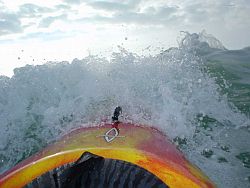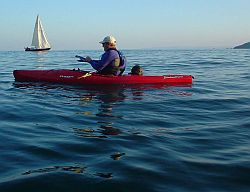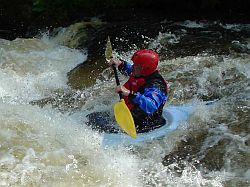


|
Paignton Canoe Club - Risk Assessment
For a PDF version of this page, click here
Paignton Canoe Club - Risk Assessment |
Prepared by Tim Durrant CWO |
Original issued August 2011 |
This assessment should be read in conjunction with the other club documents |
General statements |
Canoeing and Kayaking are ‘Assumed risk water contact sports’, that may carry attendant risks.
Participants should be aware of and accept these risks, and be responsible for their own action and involvement.
Paignton Canoe Club, it's officers and members cannot be held responsible for any loss, damage, injury or death however caused.
It is the individual's responsibility to ensure they have the sufficient knowledge, skills and equipment for the activity they have chosen to partake in.
Ensure you are familiar with all the relevant safety practices and procedures for your equipment and for the location in which you are using it |
There is no substitute for common sense and local judgment
- Rule One is to take actions to avoid emergency situations. This assessment is intended to help.
- Rule Two, in an emergency, avoid any response that adds casualties to the situation
- Rule Three is that kit can be replaced, people cannot. Focus on the people.
|
For each trip a leader should be appointed. That person should be the most experienced person for the location, conditions and planned activity.
Advice and opinion can and should be offered and sought from the group
The whole group must acknowledge and allow the leader to lead.
Experienced paddlers should be role models of good behaviour and judgment in their actions
Experienced paddlers should mentor, explain and encourage good behaviour with beginners
Encouragement is good. Peer pressure is bad.
Everyone is responsible for their own safety
Everyone is responsible for the safety of the group
Speak up if someone has concerns for themselves, or for others
Making a decision not to do something is braver and more sensible than pressing on against your better judgment. |
Canoeing and kayaking are activities based in a dynamic environment,
therefore dynamic (continual) assessment of risk against current group abilities needs to be made |
For brevity the risks and preventative measures are generally not repeated between Scenarios. Check the ‘See also..’
This document should be read in conjunction with
- The Club Health and Safety Document
- The Club Operating Procedure
|
|
Scenario |
Hazard |
Seriousness |
Preventative measures |
Travel |
|
|
|
|
Poor lifting of boats and kit |
Back strain
Damaged equipment and vehicles |
Encourage buddy lifting and carrying, experienced paddlers help beginners and those with poor practice
Train members appropriate lifting techniques ('Improver' training). |
|
Poorly secured boats to roof racks or trailer |
Injury or death to other road users
Damage to equipment |
Inspect rope or straps regularly.
Do not use bungee cord.
Train members to secure boats ('Improver' training).
When unloading place one strap on driver's seat as a reminder
Driver to take responsibility for load
Ensure load is within capabilities of vehicle and securing system
Check load security before travel, after 10 minutes driving and then regularly through journey |
|
Trailer accident |
Damage to equipment
Injury or death to other road users |
Check tyres and car towing capabilities.
Tow at correct speed.
Take extra care when reversing and ask for help |
|
Car park accidents |
Injury or death to pedestrians
Damage to equipment and vehicles |
Beware of moving vehicles, especially when changing after a paddle when tired.
Look out for vehicles, other paddlers and equipment |
|
Travel accidents |
Injury or death
Damage to equipment |
Remember wind and weight loading on vehicle, modify driving style to suit.
Beware of tiredness affecting judgment after paddling
Ensure that there is appropriate insurance cover |
Swimming Pool |
|
|
|
Water |
Drowning |
Obey pool rules.
Ensure Lifeguard is on duty at all sessions.
Ensure participants can swim.
Teach wet exit (Beginners) and capsize drill.
Experienced paddlers observe and respond |
|
Capsize entrapment |
Drowning |
Teach wet exit, Eskimo rescue, hand of God and rolling.
Experienced paddlers observe and respond |
|
Overcrowding |
Head injuries against pool-side or other users in close confines |
Ensure people advised of dangers.
Wear helmets if considered necessary.
Restrict number of people in pool dependent on activity
Stop play boat moves or swimmers if necessary |
|
Slippery Floors |
Falling injuries |
Obey pool rules. Do not run. |
|
Kayak football and other games |
Injury
Drowning |
Wear helmets and buoyancy aids
Have a referee, empowered to challenge dangerous behaviour
Restrict number of players appropriate to pool conditions
Experienced paddlers support capsizes or swimmers
Stop play if paddler in difficulty |
Canals and placid water, |
|
|
|
Water |
Drowning |
Appoint leader for activity
Leader is to lead
Group is to accept leadership
Other experienced paddles to assist leader
Ensure the activity is within capacity of the whole group
Wear buoyancy aid
Carry a whistle
Carry mobile phone and car keys on your person in waterproof container
Clarify group signal arrangements
Ensure group awareness (buddy partners)
Ensure group know who is carry what safety related equipment |
|
Collision or interference with other water users |
Collision, injury, death damage to equipment |
Keep a strong watch out for other craft.
Know the rules of the 'road' and any local considerations
Be mindful of appropriate group control for minimum impact on others
Move out of the way of all other water users, kayaks can easily maneuver in shallow waters.
Respect fishermen and other bank users
Be aware of diving and swimming activities
Carry first aid kit and know how to use it
Join the BCU for third party insurance |
|
Weirs and locks |
Drowning |
Avoid locks. Portage around them
An experienced person should inspect weir hydraulics before paddling near weirs.
Consider using appropriate white water equipment and rescue cover. |
|
Collision with hard objects |
head injury |
Wear helmets if exploring overhangs, low bridges or other such features
Look out for other water users |
|
Rubbish |
Cuts, other injuries |
Look out for and avoid.
Have first aid kit with party.
Have and know who is a trained first aider
Load a First Aid app on your smart phone |
|
Contaminated water |
Contracting Illness |
Avoid obvious pollution
Do not ingest water.
Shower after paddling.
Be aware of Weil's disease etc |
|
Cold Weather |
Hypothermia, poor judgment, death |
Dress appropriately for conditions.
Speak up if getting cold
Group members monitor themselves and others in cold conditions.
Carry ability to provide warm drinks and shelter for extended trips away from civilization |
|
Hot Weather |
Heat stroke / sunburn / dehydration |
Dress appropriately for conditions.
Group members monitor themselves and others in hot / sunny conditions.
All members advised to wear hats and apply water resistant sun-cream
Wear sunglasses if water glare
Carry drinking water and other refreshments |
|
Cold water |
Hypothermia, Immersion Hypothermia |
Dress appropriately for conditions
Group members monitor themselves and others in cold conditions.
Train and practice rescue techniques |
|
Overexertion |
Muscular injury
Poor judgment |
Perform warm up exercises at start of activity
Teach correct movement.
Consider group members abilities when planning trip.
Plan a rest stop for at least every 2 hours
Have tow line in group
Ensure someone ashore knows of paddle plan, expected return time and what to do if late |
|
Entanglement |
Injury, death |
Keep a strong look out for fishing lines, cordage and rope
Carry a knife in an accessible position |
Estuaries and sheltered sea, including harbours. Also see canal and placid water |
|
Cold |
hypothermia death |
wear appropriate clothing, esp. cage and wet suit, or dry suit
Dynamic review regarding local conditions (include weather, participant skills and experience) |
|
Currents |
Exhaustion, capsize, drowning |
Plan for strength and direction of currents
Monitor relative motion with respect to moored buoys and land features |
|
Collision with hard objects |
head injury |
Wear helmets for rock hopping and harbour based activities
Look out for other water users |
|
Entanglement |
hypothermia death |
Look out for ropes and fishing lines
Avoid wearing a cord around neck
carry a knife |
White water Grade 2 or higher. Also see estuaries and sheltered sea |
|
Bank side |
slips, head injury, drowning |
Wear appropriate shoes
wear buoyancy aid and helmet when close to water
have throw line to hand |
|
Water |
Being put off the sport, Capsize, Hypothermia, Drowning |
Appoint leader for activity
Leader is to lead
Group is to accept leadership
Other experienced paddles to assist leader
Ensure the activity is within capacity of the whole group
Check that equipment (inc boat) is appropriate for the activity
Wear buoyancy aid
wear wetsuit and cag, or dry suit
Be aware of current and expected water levels (rain history and forecast?) |
|
Collision with hard objects |
injury, death |
Wear helmet
Adopt correct defensive position if capsized
Carry first aid kit in group
Carry map and compass to identify location |
|
(Foot) entrapment |
Hypothermia, injury, drowning |
Learn to roll to reduce risk of swims
Wear appropriate foot wear
Adopt defensive swimming technique
Learn ww rescue techniques
Carry a whistle |
|
Pinning, strainers, stoppers and holes etc |
Hypothermia, injury, drowning |
Scout ahead to avoid hazards
Leaders point at the safe path not the hazard
Train for correct defensive procedure if trapped
Ensure training in group for ww rescue techniques
Know who in group has what rescue kit |
|
Long days |
Poor judgment, death |
Monitor group and self
Carry group shelter, hot drinks, energy foods
Remember there is still the journey home |
|
Lost and broken equipment |
Cost, stranding |
Rescue the person first
Inspect equipment before use and after events
Carry car keys and mobile phone on person
Carry splits as spare
Mark boat and paddle with phone number for possible re-union
Inform authorities if kit lost, to avoid unnecessary rescue alerts |
White water Centres. See also white water Grade 2 or higher. |
|
Water |
injury, drowning |
Obey the rules of the centre |
Coastal exposed. Also see estuaries and sheltered sea |
|
|
Remote incidents |
Hypothermia, death |
Agree group communications, whistles, arm signals etc
Wear and carry appropriate clothing
Carry VHF radio
Carry day and night flares
Carry tow line
Carry splits
Have a shore watch who knows plan and what to do if late |
|
Capsize |
Hypothermia, death |
Learn to roll
Practice other self and group rescue techniques
Carry a pump |
|
Navigation |
Hypothermia, death |
Weather forecast, tidal currents and races, overfalls,
Carry maps or charts and compass
Train in navigation skills |
Surfing. Also see estuaries and sheltered sea |
|
Water |
Hypothermia, death |
Wear buoyancy aid
Wear appropriate clothing |
|
Collision with hard objects |
Injury death |
Wear a helmet
Be aware of other water users and coastal geography
Obey the rules of the road |
|
Current and tides |
Hypothermia, death |
Check with experienced surfers and paddlers
Dynamic risk assessment of weather, rip tides and other influences |
|
Entanglement |
Hypothermia, death |
Be aware of ropes, lines, moorings, fishing lines etc
Carry a knife |
In addition to the above, these local hazards should be part of the leader’s judgment:
Paignton Harbour area
The area of the Coastguard depot and associated parking should not be blocked at any time.
The Sailing Club changing room door opens straight out onto roadway. Take care when exiting.
Under some sea states there can be a large surge affecting the main south slipway and the pontoon; consider using the west slip if necessary.
There is much activity from many interested groups around the slipways, both on and off the water. These include:
- Reversing cars and trailers
- Long rowing boats and gigs
- Power boats and jet skis
- Sailing boats
- Other vehicles and craft
Not all these users will be experienced handlers of their equipment. Exercise great care and watch out for others who may be tired or otherwise with reduces judgment, lest they become either hazards or victims.
At low tides the harbour dries. Beware of soft sand patches; it is not recommended to drive vehicles onto the sand.
Beware of fishing lines and surf rolling past the mouth of the harbour
Paignton Harbour mouth is unusual in that passage is on the left because of the location of the passenger embarkation. Exit and enter the harbour on the left and as a close group for maximum safety and mutual support whilst making minimum disruption to others.
The perch and pier present hazards both from the metalworks and crustacean attached. Helmets should be worn if close manoeuvring in these areas is planned.
The ducted stream from the harbour to the perch and associated reef dries at low tide. There are iron works protruding from these features that will damage people and equipment at certain tide heights. Ensure sufficient water for the sea state is over these features before venturing into the area protected by the perch cardinal marker.
In the cove on Roundham Head (Savage Hole) there are the remains of a WW1 submarine. Around low tides some ironworks present a hazard. Avoid this feature under those conditions.
Peregrine Falcons nest on Roundham Headland. When eggs and young are present they may be very opinionated about small boat activities nearby. Move away quietly and quickly if there are signs of disturbing the birds.
Caves underneath Livermead Head require helmets and awareness of sea state and tide before entering.
Reviewed at AGM Sept 2012
|
|



